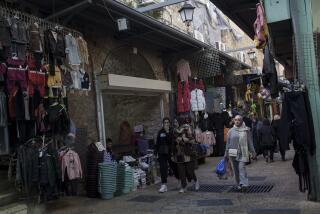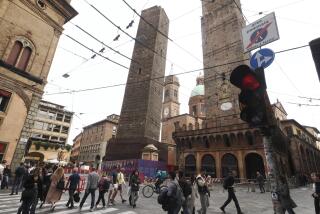Fear of Collapse Adds to Disputes Over Jerusalem’s Temple Mount
- Share via
JERUSALEM — What would happen if the Temple Mount, the holiest site in Judaism, the third-holiest in Islam and perhaps the most contentious plot of real estate in the world, suddenly collapsed?
As if there wasn’t enough to worry about in the Middle East, a group of Jewish archeologists is warning that a 35-foot-wide bulge in the complex’s southeastern supporting wall is in serious danger of rupturing. An accident could prove especially deadly if it happened during the Muslim holy month of Ramadan, which begins around Nov. 6 and is expected to draw up to 200,000 worshipers to the site. It is also feared that even a small accident could trigger a new outbreak of Israeli-Palestinian violence.
“I’m not a prophet. I can’t say exactly when, but there is no question that it will collapse,” said Gabriel Barkai, an Israeli archeologist.
Israelis say they noticed the bulge about two years ago when it was, in the words of Hebrew University archeologist Eilat Mazar, a few months pregnant. Now, she says, it is at the equivalent of eight months and on the verge of bursting.
“You can see it with your bare eyes. It is protruding more and more every time you look at it,” said Mazar, who along with Barkai is part of an ad hoc group of archeologists and political figures calling themselves the Committee for the Prevention of the Destruction of the Antiquities on the Temple Mount.
The Temple Mount -- known to Muslims as the Haram al Sharif, or “noble sanctuary” -- is part of the Old City of Jerusalem, captured by Israel in the 1967 Middle East War. At the western retaining wall, Jews come to pray and grieve for the temple that once dominated the site and was destroyed by the Romans in AD 70. The top of the mount is home to Al Aqsa mosque and the golden Dome of the Rock, the most famous monument in Jerusalem’s skyline.
Although Israeli police patrol the site, day-to-day administration is handled by an Islamic trust run mostly by Palestinians. All too predictably, Israelis and Palestinians are at such loggerheads over the protruding wall that the Israeli media have dubbed the entire affair the “Battle of the Bulge.”
Among the points of contention are how serious the bulge is, who should be responsible for fixing it and -- the omnipresent question in the Holy Land -- who is to blame?
“The usual stupidity prevails,” said Oleg Grabar, a professor with Princeton University’s Institute for Advanced Study who has occasionally been called on to mediate Holy Land archeological disputes for the United Nations Educational, Scientific and Cultural Organization. “Almost anything you touch in this part of Jerusalem will cause some sort of problem.”
The Waqf, the Islamic trust in charge of the holy sites on the mount, agrees there is a problem but says it can easily be fixed. The trust erected scaffolding around the bulge early this year to begin repairs, but it was stopped by Israeli police in April after some Israeli archeologists complained that its approach could make the problem worse. (“They were putting on a little glue here and there. It was like treating cancer with aspirin,” Barkai said.)
From an office overlooking Al Aqsa and the Dome of the Rock, the trust’s director scoffs at the fuss created by the Israeli archeologists.
“This is a joke. It is all politics,” said Adnan Husseini. “This is something that we are able to fix, but Israelis want to use this to create more tension in the atmosphere.”
Husseini says the bulge in the ancient wall dates back hundreds of years and has been aggravated by various natural calamities, notably a 1920 earthquake. Only about 20% of the repairs had been completed when the trust was stopped by Israel. The plan had been to finish the repairs before the winter rains, which could sharply increase the risk of a collapse.
“The Israeli government will be responsible if there are lives lost,” Husseini said.
The Temple Mount is notorious for the strong emotions it stirs. A September 2000 visit to the site by Ariel Sharon, before he became prime minister, sparked riots that marked the beginning of the current Palestinian uprising. In 1996, the opening of a small exit to a tunnel in the mount also set off riots among Palestinians, who believed it was a nefarious plot to undermine the foundation of Al Aqsa and the Dome of the Rock.
The same Israeli committee that is warning about the bulge alleges that the Islamic trust is trying to eradicate archeological evidence that a Jewish temple ever stood on the site.
The Israeli archeologists point specifically to an ambitious project that the Waqf started in 1999 to open a large mosque in an underground vault known as Solomon’s Stables. They complain that tons of valuable archeological debris were thrown away in the process of opening the site, and Barkai suspects that the laying of paving stones for the mosque might have created a drainage problem that has contributed to the growth of the bulge.
“It needs a thorough survey by engineers to determine exactly what is happening, but we can’t get in,” Barkai said.
So rancorous is the atmosphere that the Israeli committee has hired private aircraft to take aerial photographs of the site every few weeks to look for construction work by the Waqf.
But even within the Israeli government, there is disagreement about the immediacy of the danger. Shmuel Ben-Ruby, a spokesman for the Israeli police, says the archeologists may be overly panicked.
“Let’s just say that people are making more noise than is necessary,” he said.
Sharon has seized responsibility for the dispute because of its sensitivity, and his office is trying to strike a compromise with the Waqf to have the repairs completed. A team of Jordanian engineers inspected the wall earlier this month and might be called on to oversee the repairs. Another possibility would be to have the work supervised by UNESCO, but Israel might object to involvement by the U.N. agency, with which it has had a contentious relationship.
Sharon’s office declined comment on the matter, other than to say in a statement by Cabinet Secretary Gideon Saar that “the Israeli government believes this is a serious problem.”
“This issue is being dealt with discreetly for the sake of optimal treatment,” Saar’s statement added. “We don’t elaborate about it in the media.”
More to Read
Sign up for Essential California
The most important California stories and recommendations in your inbox every morning.
You may occasionally receive promotional content from the Los Angeles Times.













